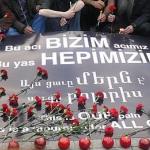Speaking at the panel “What happened on April 24, 1915?”, organized by the Human Rights Association (İHD), Ara Sarafian, a historian at the Gomidas Institute, who specializes in the late Ottoman period, told that “April 24 was the political act of the Committee of the Union and Progress. April 24 opened the way for the liquidation of the Armenians in Anatolia.”
The publisher Ragıp Zarakolu, the lawyer Eren Keskin and the writer Erdoğan Aydın participated in the panel held at İstanbul Bilgi University yesterday. While more than three hundred people watched the panel, there were many police officers around the university.
April 24 stands for the few days in 1915, during which 220 Armenian intellectuals in Istanbul were arrested and today this day is acknowledged as the “genocide commemoration day” by all the Armenians around the world.
“The same mentality persists”
Giving the opening speech, the IHD branch president Gülseren Yoleri stated that the genocide claims were still neither discussed nor accepted and the same was the case regarding the Kurdish problem.
“They could not live in their own land, nor die in it. They made enemies out of Kurds, Turks, Armenians, Greeks, the neighbors.”
Stating “the mentality of the Committee of the Union and Progress continues”, Keskin added that “If we do not discuss the Committee of the Union and Progress, the Special Organization (Teşkilat-i Mahsusa), Şemdinli incident, 6-7 September pogrom of 1955 against Greeks in Turkey and the latest Ergenekon incident, we will not get very far.”
“We have failed to come to terms”
Saying “I think that there is a generation that represents an enlightened conscience, like the hundreds of thousands who walked behind Hrant”, Aydın likewise added that “Since we did not come to the terms with what Armenians, Assyrians, Syrians went through, the Kurdish problem, the May First celebrations, the Alevi problems persist as individual paranoids.”
Zarakolu also stated “April 24 also forms a model for the arrests of the intellectuals.”
“There is a visible and an invisible state: there is the Special Organization and the Ottoman civil servant who could not adjust to this new method.”
Reading an article Hrant Dink wrote about April 24, Zarakolu added that “This society can emphatize, provided that nobody overshadows it.”
Sarafian: There were 2 million Armenians in 1913
Sarafian talked about the historical documents regarding the genocide claims.
“According to the 1913 census of the Istanbul patriarchate, there were 2 million Armenians within the borders of the Ottoman Empire. The great majority of Armenians lived in the country with Turks and Kurds, intermingling with Muslims. Most Armenians lived in Istanbul and in the East. Those Armenians not in the war zone were exiled as well.”
“40 thousand Armenians lived in Harput, divided into 50 settlement regions. Not a single village was left after 1915. Harput plain was not a war zone. The local Armenians were very passive and they could do nothing against genocide.”
“On April 24, 1915, Armenians from various professions in Istanbul such as intellectuals, politicians, artists, and teachers were sent to Ayaş and Çankırı. In Ayaş, 55 out of 70 people were slained. About the fate of the 150 Armenians who were sent to Çankırı, no definite information has been discovered.
* This news was compiled from Atılım, Milliyet and Radikal.












